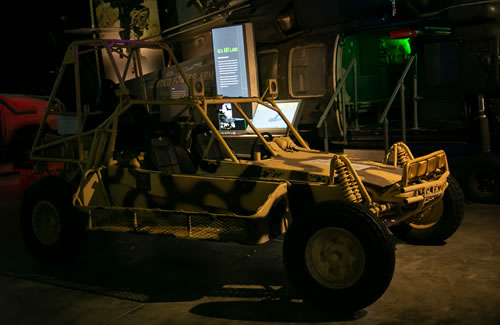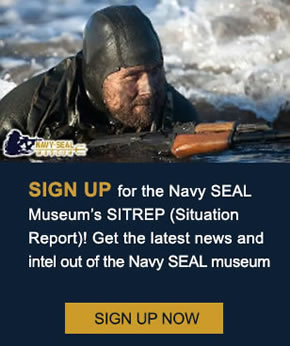Desert Storm Vehicles
 The collection outside the Museum includes two vehicles that have become iconic since OPERATION Desert Storm and hostilities since 9/11.
The collection outside the Museum includes two vehicles that have become iconic since OPERATION Desert Storm and hostilities since 9/11.
1987 Model 998 HMMWV High Mobility Multipurpose Wheeled Vehicle HUMVEE
The HUMVEE in our collection is a prototype of the ones used by SEALs today. This vehicle has been heavily reinforced with steel plates and composite armor designed to protect occupants from Improvised Explosive Devices (IEDs). The extra thick safety glass adds ballistic protection.
Humvees were developed to replace Jeeps, a vehicle in use since World War II. They debuted on active duty in 1985. Like the venerable Jeep, Humvees are four-wheel drive and an automatic transmission and are considered among the most capable all-terrain vehicles in the world. They are noted for their versatility and are used as troop carriers, command vehicles, ambulances, for psychological operations and as a weapons platform. Typical armaments include a .50 caliber machine gun, TOWs (Tube-launched, Optically-tracked, Wire-guided missiles), MK-19 Automatic Grenade Launchers.
Up-armored Humvees like this one have become the standard in Afghanistan and Iraq post 9/11.
Light Tactical All Terrain Vehicle (LATV)
The United States Special Operations Command (SOCOM) needed a fast, dependable, lightweight and agile vehicle to assist the Teams in their missions. The Light Tactical All Terrain Vehicle (LATV) Kawasaki Teryx 759 F1 4×4 met all those requirements plus. Small but mighty, the vehicle can perform its duty in the roughest terrains. This LATV saw action in Jalalabad, Afghanistan.
Three passenger Desert Patrol Vehicles (DPV)–also called Fast Attack Vehicles–like this one were used by Navy SEALs in OPERATIONs Desert Storm, Enduring Freedom and Iraqi Freedom. They are effective for operating in desert environments and rough terrain that is typical to Afghanistan and Iraq. DPVs typically operate in pairs for mutual support during combat search and rescue missions and other operations behind enemy lines. The DPV in our collection was built by Chenowth Racing Products, Inc. in El Cajon, CA. The vehicles were modeled on dune buggies and sandrails used by off-road enthusiasts in in the Western US.
The LATV in our collection features a rear-mounted 200 horse power Volkswagen engine and can go from 0 to 30 mph in four seconds, reaching speeds of 80 mph. Its 21 gallon fuel tank gives it a range of 210 miles, with a back-up fuel bladder that adds almost 1,000 miles to that capability. This light versatile vehicle could be transported by helicopter to drop into a variety of terrains. DPVs operating during Desert Storm would have been armed with one M2 .50 caliber heavy machine gun, two M-60 7.62 light machine guns, two AT-4 anti-armor rocket launchers and a variety of individual SEAL weapons. It carried a secure communication system and a GPS system.
The first Americans to enter Kuwait City during Operation Desert Storm were Navy SEALs in DPVs.

